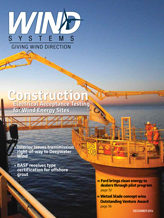Someone recently asked me about the “zippers” on the blade.
Zippers? What Zippers?
Okay, so it appears we take for granted that everyone understands wind turbine blade parts and attributes. Let’s take some time and describe the different parts of the blade.
Blade Root
The root allows for the blade to be attached to the blade and to transfer all the blade and wind loads to the main shaft. Most blade roots are round today but some have been shaped square in the past.
Blade Tip
This is the outer most part of the blade. Most turbines today are pitch regulated but some turbines that are stall regulated have a pivoting blade tip. The pivoting blade tip can be the primary method of slowing the turbine down for braking the turbine or it can be an emergency brake should the turbine go into overspeed. The old Fayette turbines of the ‘80s did not have brakes and were designed to run with the blade tips out- normal operation- so turbine over speeds were not possible.
Trailing Edge
The trailing edge of the blade is the end of the airfoil. It is usually the knife edge of the blade although today the trailing edge can be what is called a “flat back” airfoil in which the knife edge is cut off flat. This allows for stronger structures and less weight.
Leading Edge
This is the part of the blade that tends to get the most attention for service today. The leading edge is the part of the blade that first hits the wind in normal operation. The leading edge is usually fatter than the trailing edge and typically should be smooth with no imperfections.
Airfoil
I once read in a blade forum that if it looks like an airfoil it probably is. The airfoil shape seems to be very sensitive to changes. If you change it slightly, like with leading edge erosion or even just brush marks in the coating, then you change that airfoil. In fact, you have just changed the airfoil into another airfoil, with different performance curves.
Chord
If you draw an airfoil on a piece of paper and then draw a straight line from the two farthest parts of the airfoil- from the leading edge to the trailing edge, you have just drawn the chord line. Usually the chord is indicated in meters , measured from the root of the blade. This reference is used so that you know which part of the airfoil is being referenced in a discussion or report.
Long Side (Round Side, Aero Low Pressure Side, Structural High Pressure Side)
This is the side of the blade that develops low pressure in which the blade then tries to move into. Notice that this is also the high pressure side structurally as the blade skin is compressed as the blade loads up and typically bends back toward the aero low pressure side, down wind. Most commonly referred to as the Low Pressure side.
Short Side (Flat Side, Aero High Pressure Side, Structurally Low Pressure, or Tension Side)
This is the side of the blade that remains at atmospheric pressure, which is relatively higher pressure than the other side of the blade. This side of the blade usually operates in tension like a rope as the blade flexes back. This is usually the up wind side of the blade. This is most commonly referred to as the High pressure side.
Lift
Is what is generated when the airfoil passes in the wind. This is the force that we use to rotate the rotor which is generated by properly orientating the airfoil in the wind.
Drag
Drag is the friction generated by the airfoil as it passes in the wind. Sometimes drag is good such as when the winds are very strong and you don’t want to absorb more power. But most of the time we are concerned with drag costing us energy as it robs us of being able to produce more electricity. Leading edge erosion can cause additional drag as well as change the performance of the designed airfoil. Adding vortex generators in the wrong area can increase drag so be careful.
Vortex Generators
Are devices that are typically added to the Aero low pressure side of the blade to help improve lift. The devices cause the air to swirl which in turn helps keep the air flow attached to the skin which also helps reduce drag. Vortex generators help prevent stall. ( also referred to as zippers)
Trip Tape
Is used to cause a disturbance in the airflow. Although this disturbance may cause drag, it is planned that this purposely installed issue will prevent a much larger issue of unwanted stall or drag which will cost much more than the minor problem it may cause.
Stall
Is the loss of lift caused by the separation of the air flowing over the Aero low pressure side of the blade. If an airplane stalls you would know it as it would start to drop from the sky.
Pitch Marks
Are usually placed at the root of the blade, both inside and outside to help properly mount the blade and to adjust blade pitch. The marks are usually are parallel or line up with the chord line of the airfoil at the very tip of the blade.
Root Cuff
Also known as the “shark fin” if you’re from the U.S Windpower group… This is the transition point from the round root shape to the active airfoil of the blade. It is usually the widest portion of the blade with the largest airfoil chord.
Okay, so some of these terms or others that describe parts or functions of the blade are strange but all of them have been used to describe parts of a blade. Hopefully it helps you improve communication within your group at your wind farm. Discussing them amongst your team will help remove confusion and improve communication.
As always work as safe as possible and work to prevent surprises.





























